There’s a hidden gem in Brussels, located just outside the heart of the old city, which far too many visitors miss: The Cinquantenaire Museum. Elegantly positioned inside Brussels’ Parc du Cinquantenaire, the Cinquantenaire Museum is teeming with priceless ancient, medieval, and modern treasures from around the world. This January, I was lucky enough to visit the museum with Nigel Hetherington of Past Preservers and see firsthand why the museum is aptly called “Belgium’s Louvre.”
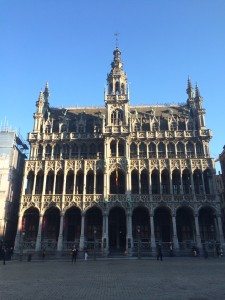
The weak rays of a wintry sun hit Brussel’s iconic Grand Place. (Photo Credit: James Blake Wiener for AHE, 2016.)
Although I had to catch an early train from London’s St. Pancras’ Station on a horrendously cold morning, I was excited at the prospect of a day trip to the Belgian capital and delighted to find out that I had been bumped up to business class on Eurostar. (I still have no idea as to why or how this happened, but I knew that the rest of the day would hold other surprises!) It took only two hours to reach Brussels’ Gare de Midi station and after a brief stop at the fêted Grand Place, Nigel and I were off to the Cinquanternaire Museum, which is easily accessible by Brussels’ subway system.
The Cinquantenaire Museum (French: Musée du Cinquantenaire; Flemish: Jubelparkmuseum) sits to the east of Brussels’ old city center and the colossal European Parliament in southeast corner of the Parc du Cinquantenaire (Flemish: Jubelpark). The infamous Leopold II (r. 1865-1909 CE) ordered the construction of a triumphal arch and a series of ornate complexes within the park to commemorate the 50th anniversary of the independence of Belgium. While chiefly remembered for his imperialist policies in the Congo and massive urban renewal projects, Leopold II also sent Belgian archaeologists and researchers around the world to study and document the breadth of human history. This is explains why the Cinquantenaire Museum is filled with splendid cultural treasures from five continents, and on par with renown museums like the Louvre and the British Museum. The Cinquantenaire Museum is the largest museum in Belgium and thus functions as the current headquarters of the Royal Museums of Art and History.
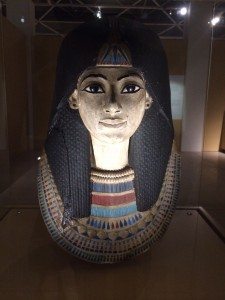
Gorgeous ancient sculptures await visitors to the Cinquantenaire Museum’s Sarcophagi exhibition. (Photo credit: James Blake Wiener for AHE, 2016.)
Upon arrival at the museum, Nigel and I examined the museum map to decided how we should begin our day at the museum. The Cinquantenaire Museum’s collections are divided into four chief collections: National Archaeology with archaeological items and treasures from Belgium’s ancient past; Antiquity with art and artifacts from the ancient Mediterranean and Near East; European Decorative Art with sumptuous pieces reflecting styles from the Middle Ages to the Art Deco from the 1930s; and Non-European Civilizations with artwork from the Islamic world, the ancient Americas, India, East Asia, Oceania, and Polynesia.
We decided to visit first the Sarcophagi: Under the Stars of Nut exhibition, which is on show until April 20, 2016. The exhibition showcases the masterpieces of the museum’s enormous ancient Egyptian collection, including coffins, death masks, embalmed animals, and a variety of funerary artifacts. The objects on display dated from the early dynastic period through the Roman occupation of Egypt, so there was quite a lot to see and absorb. While ancient Egyptian conceptions of life and death are explored and detailed throughout the exhibition, I was drawn to the sarcophagi of the animals and in particular that of a mongoose, which had been lovingly mummified and buried over two thousand years earlier. One also could find mummified birds, cats, and crocodiles throughout the exhibition.
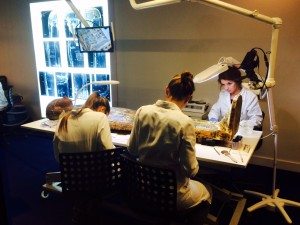
Art restorers work to preserve and ancient Egyptian sarcophagi in real time. (Photo Credit: James Blake Wiener for AHE, 2016.)
Artifacts with magical and mythological implications — like colorful charms used in spells and bejeweled amulets — captured my curiosity as well. The majority of objects on display within Sarcophagi have never been exhibited outside of Belgium, and it was a rare treat to see such a comprehensive show on ancient Egypt. Much to our mutual surprise, one of the highlights of the Sarcophagi is its conclusion: The exhibition ends with the chance to see an Italian restoration team at work, behind plexiglas, as they restored coffins belonging to Theban priests in real time! Wow! I definitely wasn’t expecting to see that. The total collection of ancient Egyptian artifacts at the Cinquantenaire Museum numbers more than 11,000 pieces, so I’m hopeful that another show will be arranged exploring different themes or a single historical era in the near future.
After exploring the exhibition, Nigel and I decided to partake in a sumptuous Belgian lunch with wine and salad at the museum’s Restaurant Le Midi 50, which was delightful. Belgian cuisine is really among the most delicious but also filling! To work off our calories and devote our remaining time solely to the museum, Nigel and I split up to explore independently. The Cinquantenaire is gargantuan in size! (Take a look at this museum guide and map if you don’t believe me.) To do it any justice, you need at least three or four hours.
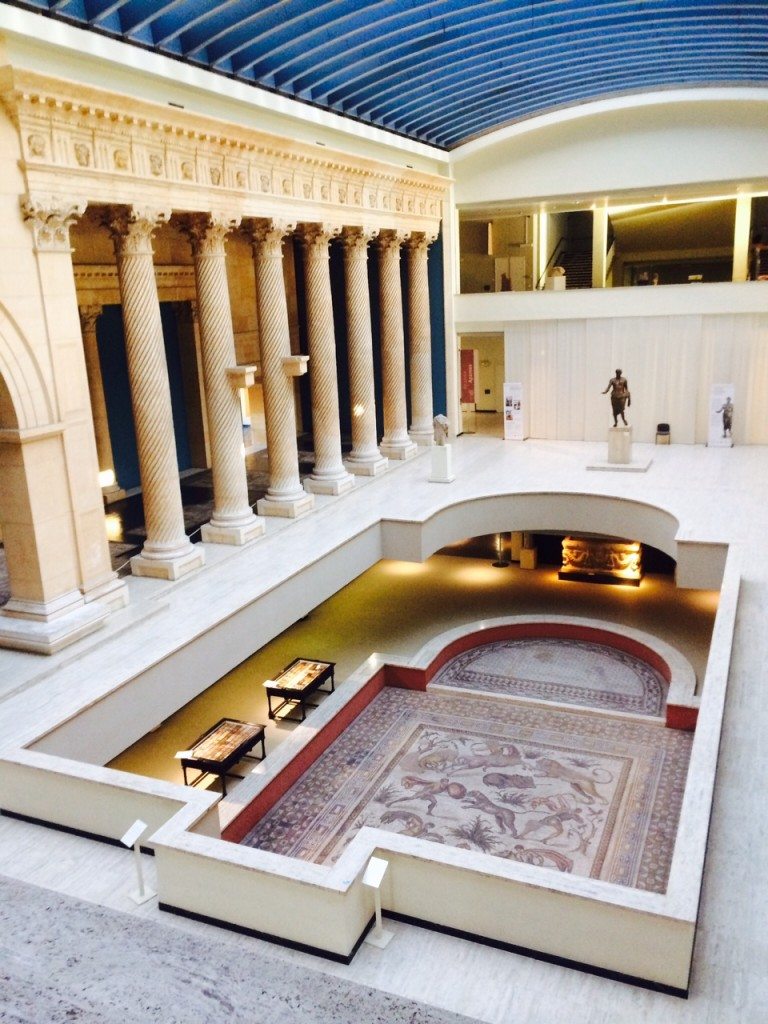
The grand colonnade of Apamea with the “Great Hunt Mosaic” in the foreground. (Photo Credit: James Blake Wiener for AHE, 2016.)
I headed straight to the grand colonnade of Apamea, which was reconstructed at the Cinquantenaire Museum as a reminder of the 19th-century Belgian Missions in the Levant. Apamea, located on the Orontes River some 55 km (34 m) northwest of Hama in what is present-day Syria, was once a bustling Roman and later Byzantine city. The city counted such notables as Posidonius (135-51 BCE) and Iamblichus (c. 245-c.325 CE) among its residents, and the city’s Roman theater is one of the largest surviving theaters still in existence. The highlight of the Roman collection, and indeed, the Cinquantenaire Museum, though is the Roman mosaic from Apamea, Syria, depicting a hunting scene. It’s stunning in beauty and massive in size. The museum’s Roman collection includes other beautiful Syrian mosaics as well as numerous idealized marble figures and Roman copies and imitations of famous Greek originals. For those interested in ancient Greece, there’s a fine Greek collection next to the “Apamea” room with exquisite Greek vases, dating from Bronze Age to the Hellenistic period.
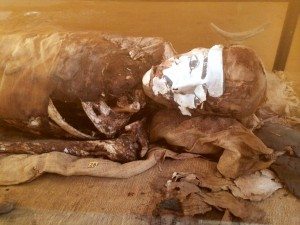
One of the various mummies on display in the Cinquantenaire Museum’s ancient Egyptian collection. (Photo Credit: James Blake Wiener for AHE, 2016.)
Although I had just seen the Sarcophagi exhibition, I couldn’t resist seeing more of the Cinquantenaire’s impressive ancient Egyptian collection. Among the most prized artifacts are the “Lady of Brussels” a limestone figure of a woman (c. 2700 BCE) and an exquisite relief image of Queen Teje, the wife of Amenhotep III (c. 1375 BCE). There is also a reconstruction of an burial chamber — the mastaba of Nefertitenaf (c. 2400 BCE) — and various sarcophagi and mummies from different periods.
Realizing that I had only a precious few hours left at the Cinquantenaire before it would be time to take the train back to London, I decided to make way to the Near Eastern collection, located in the museum’s lower level. Hundreds of tablets, cylinder seals, ceramic items, reliefs and other artifacts fill a large room that felt as large as a football field! While the majority of the collection’s highlights are from successive ancient Persian dynasties — Belgian archaeologists had been particularly interested in ancient Persia and the region of Luristan in particular — Assyrian, Nabataean, and ancient Arabian pieces make an appearance as well. The entire collection appeared to be in the process of reorganization as I saw several museum curators scurrying about with measuring tape, notebooks, and digital cameras.
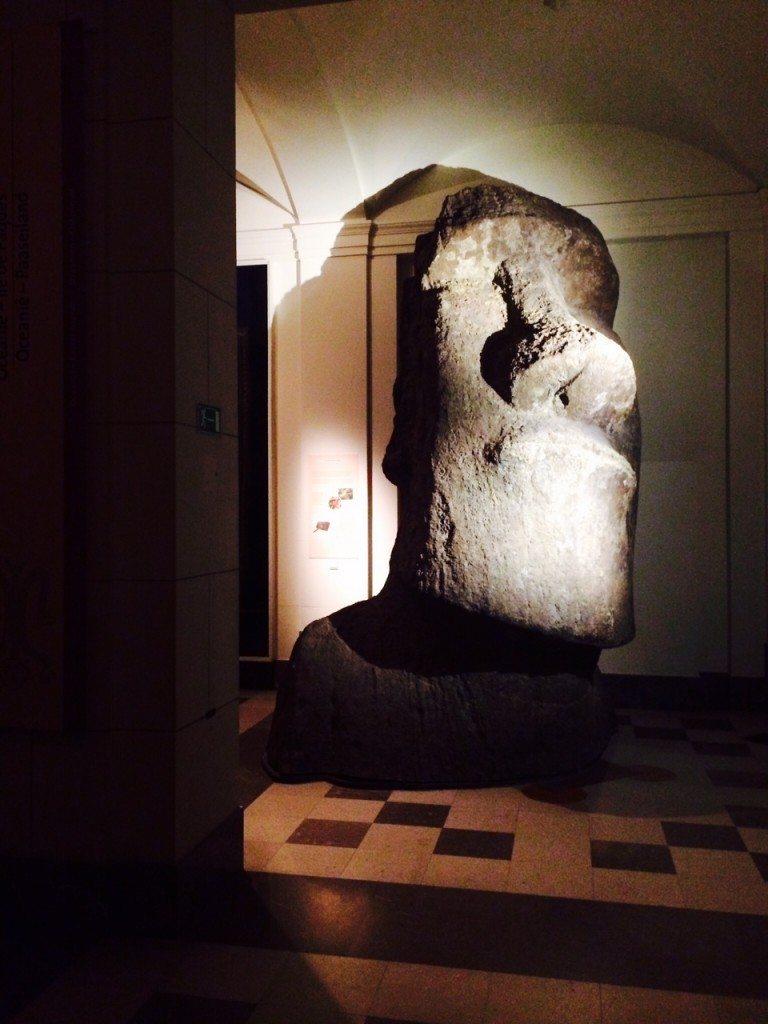
Belgian archaeologists brought this moaii from Easter Island to the Cinquantenaire Museum in the 1930s. (Photo Credit: James Blake Wiener for AHE, 2016.)
I felt the need to escape the Near East, so after walking through an Islamic gallery splashed in the beauty of winter twilight, I headed to the ancient Americas collection. I felt as though I were walking into the unknown, as I didn’t realize that the Cinquantenaire Museum is one of the most important museums for Pre-Columbian and Native American art. In addition a stunning array of artifacts from the Maya, Aztec, and Inca civilizations, I also saw the world’s oldest Inuit kayak, a life-size, Olmec terracotta seated figure from El Zapotal in Mexico, handsome Mochica ceramics from Peru, and feather robes handcrafted by Brazilian tribes along the Amazon River. Before leaving the ancient America’s collection, I caught a colossal, six-tonne stone sculpture from Easter Island out of the corner of my eye in a small room devoted to the Franco-Belgian Easter Island Expedition of 1934-1935. Unreal!
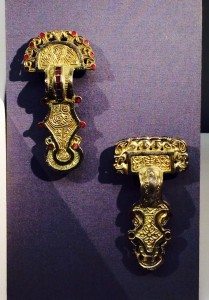
Merovingian fibulae discovered in Belgium, dating from the sixth to seventh centuries CE. (Photo Credit: James Blake Wiener for AHE, 2016.)
A new nation at the heart of “old” Europe, Belgium nonetheless has a checkered, ancient past. Celts, Gallo-Romans, and Frankish tribes all inhabited what is present-day Belgium, and it should be remembered that “Belgium” is derived from the ancient Celtic tribe of the Belgae. To conclude my visit at the Cinquantenaire Museum, I wanted to visit the National Archaeology collection. While I enjoyed seeing an incredible ancient Celtic golden ornament that once decorated a drinking-horn and items from Roman graves, the Merovingian objects are without a doubt the most beautiful objects in this collection. Merovingian jewelry as exquisite as it is ornate. Additionally, eight graves from Harmignies — a small village located in Hainault, Wallonia — have been reconstructed and filled with original funerary gifts and skeletons dating from the Merovingian heyday.
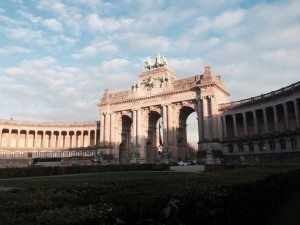
The centerpiece Arc du Cinquantenaire and its U-shaped arcade in twilight. (Photo Credit: James Blake Wiener for AHE, 2016.)
As the winter sun set, Nigel and I found our metro stop and made our way back across town to the train station. Although we were both exhausted, we couldn’t have had a more exhilarating day exploring a museum with a storied past and rich repertoire of fascinating archaeological items.
Cinquantenaire Museum
HOURS
Cinquantenaire Museum Parc du Cinquantenaire 10, 1000 Brussels, Belgium. [email protected]; tel.: + 32 (0)2 741 72 11. Opening hours Galleries Tuesdays to Fridays: 9.30 AM to 5 PM. Saturdays and Sundays: 10 AM to 5 PM. Exhibition — “Sarcophagi” — Tuesdays to Fridays: 10 AM to 5 PM. Saturdays and Sundays: 10 AM to 6 PM. Closed on Mondays, January 1, May 1 , November 1 and 11, and December 25. Ticket office closes at 4 PM.
TRANSPORTATION
Metro: The nearest stations are “Schuman” and “Merode.” Bus: 22, 27, 80: stop at “Galliërs”; 61: stop at “Merode.” Tram: 81, 82: stop at “Merode.”
ADMISSION
Collections € 8: adults (26-64 years); € 6: young adults (19-25 years), senior citizens (65 +), groups (min. 15 persons), ‘Visit Brussels’, ‘Must of Brussels’; € 2: children (4-18), unemployed persons, disabled persons; Free: children (-4), journalists, Belgian teachers, members of the press and of the ‘Per Musea’ support group, Friends of the Educational Service, Friends of the RMAH, ICOM, guides of the City of Brussels, members of the staff of PP Politique Scientifique Audioguide.
An audio guide for the galleries Romanesque and Mosan Art, Gothic-Renaissance-Baroque, Art of the Islamic World, is available in English, French and Dutch and costs € 3. Free admission on the first Wednesday of every month from 1 PM until closing at 5 PM.
All images featured in this post were taken by James Blake Wiener for AHE. James Blake Wiener was responsible for the editing for this piece. Unauthorized reproduction is strictly prohibited. All rights reserved. © AHE 2016. Please contact us for rights to republication.
top

